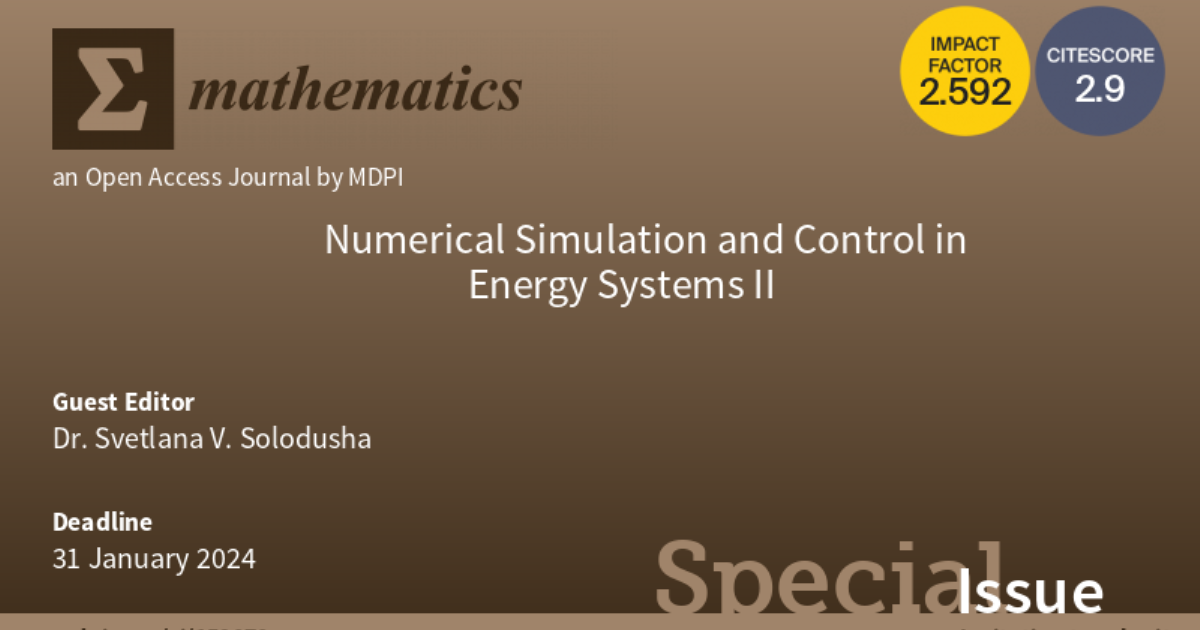Numerical Simulation and Control in Energy Systems, 2nd Edition
A special issue of Mathematics (ISSN 2227-7390). This special issue belongs to the section "Engineering Mathematics".
Deadline for manuscript submissions: closed (31 January 2024) | Viewed by 5322

Special Issue Editor
Interests: integral equation and their applications; computational mathematics; dynamical systems; inverse problems
Special Issues, Collections and Topics in MDPI journals
Special Issue Information
Dear Colleagues,
The modern development of science and technology prioritizes the design of mathematical models and methods for applications in the energy industry. This Special Issue aims to collect research papers reflecting the latest advances in the field of numerical simulation and control in power and energy systems. The range of scientific problems for the Special Issue includes current issues in the theory of mathematical modeling, identification, and control in technical energy systems. Topics of interest range from analytical and computational methods to algorithmic and applied solutions and aim to popularize new ideas, concepts, and methodologies in the description of complex energy systems. Potential topics include (but are not limited to) the following areas:
- Models taking into account the hierarchy of energy facilities;
- Methods of mathematical modeling, taking into account the new properties of equipment and the requirements of universality;
- Identification methods;
- The analysis and synthesis of control modes;
- Numerical simulation for control systems;
- Dynamic measurement methods for physical quantities;
- Complex problems of intelligent modeling and control systems in the energy sector.
High-quality research and surveys reflecting the current state of affairs are welcome. Particular attention should be paid to the practical application of research results.
Dr. Svetlana V. Solodusha
Guest Editor
Manuscript Submission Information
Manuscripts should be submitted online at www.mdpi.com by registering and logging in to this website. Once you are registered, click here to go to the submission form. Manuscripts can be submitted until the deadline. All submissions that pass pre-check are peer-reviewed. Accepted papers will be published continuously in the journal (as soon as accepted) and will be listed together on the special issue website. Research articles, review articles as well as short communications are invited. For planned papers, a title and short abstract (about 100 words) can be sent to the Editorial Office for announcement on this website.
Submitted manuscripts should not have been published previously, nor be under consideration for publication elsewhere (except conference proceedings papers). All manuscripts are thoroughly refereed through a single-blind peer-review process. A guide for authors and other relevant information for submission of manuscripts is available on the Instructions for Authors page. Mathematics is an international peer-reviewed open access semimonthly journal published by MDPI.
Please visit the Instructions for Authors page before submitting a manuscript. The Article Processing Charge (APC) for publication in this open access journal is 2600 CHF (Swiss Francs). Submitted papers should be well formatted and use good English. Authors may use MDPI's English editing service prior to publication or during author revisions.
Keywords
- differential/partial differential equations
- integral equations
- dynamical systems
- numerical methods
- mathematical modeling
- artificial intelligence methods
- mathematical programming
- identification and modeling of control systems
- data processing
- application in power and energy systems
Benefits of Publishing in a Special Issue
- Ease of navigation: Grouping papers by topic helps scholars navigate broad scope journals more efficiently.
- Greater discoverability: Special Issues support the reach and impact of scientific research. Articles in Special Issues are more discoverable and cited more frequently.
- Expansion of research network: Special Issues facilitate connections among authors, fostering scientific collaborations.
- External promotion: Articles in Special Issues are often promoted through the journal's social media, increasing their visibility.
- e-Book format: Special Issues with more than 10 articles can be published as dedicated e-books, ensuring wide and rapid dissemination.
Further information on MDPI's Special Issue polices can be found here.





